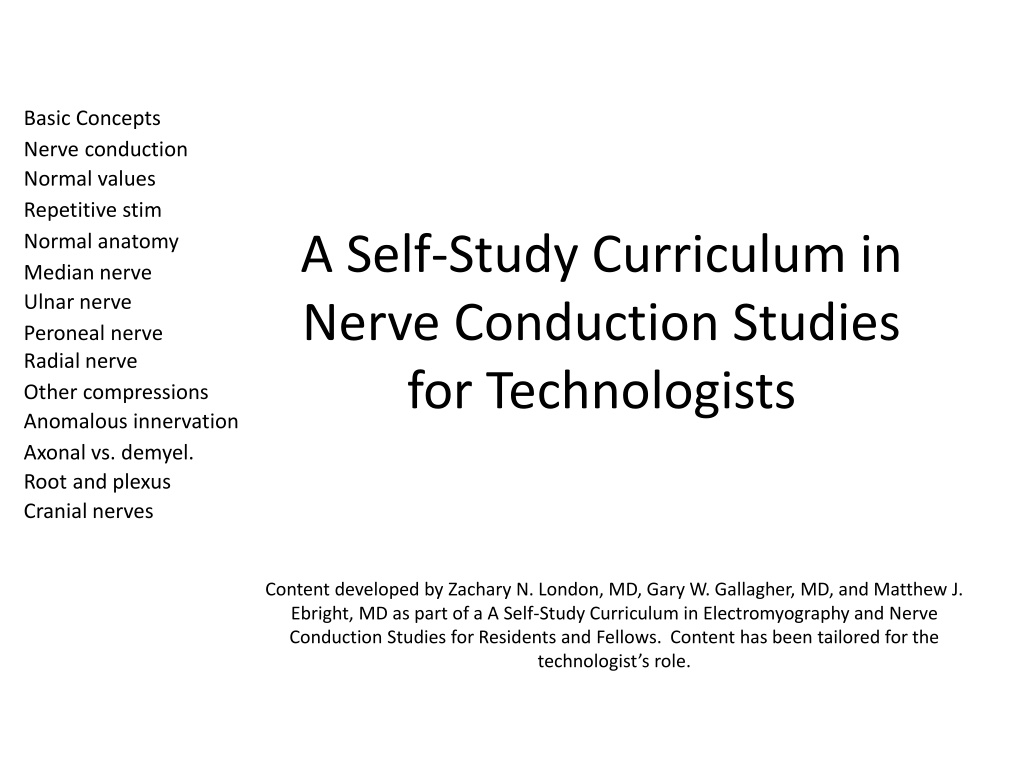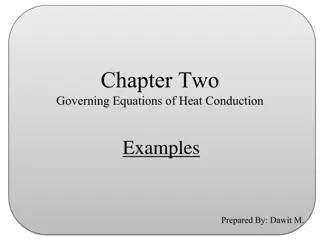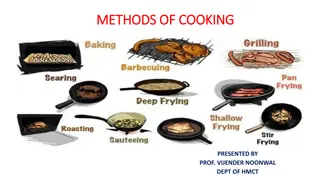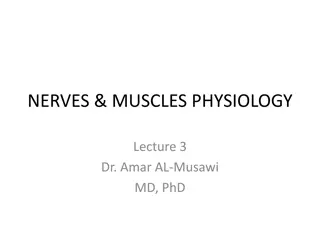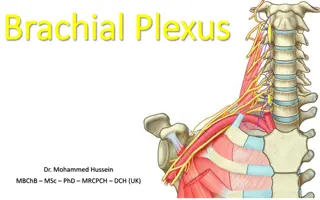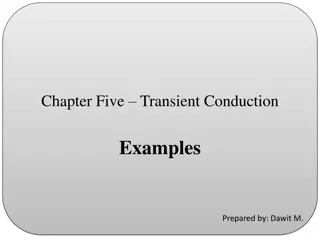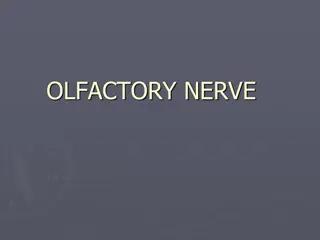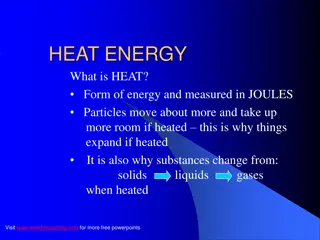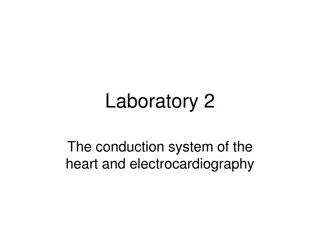Understanding Electrical Concepts in Nerve Conduction Studies
Exploring the fundamental electrical properties in nerve conduction studies, including charge, voltage, current, and impedance. Learn about normal values, anatomy, and anomalies in nerve function. This self-study curriculum is designed for technologists interested in electromyography and nerve conduction studies.
Download Presentation

Please find below an Image/Link to download the presentation.
The content on the website is provided AS IS for your information and personal use only. It may not be sold, licensed, or shared on other websites without obtaining consent from the author. Download presentation by click this link. If you encounter any issues during the download, it is possible that the publisher has removed the file from their server.
E N D
Presentation Transcript
Basic Concepts Basic Concepts Nerve conduction Normal values Repetitive stim Normal anatomy Median nerve Ulnar nerve Peroneal nerve Radial nerve Other compressions Anomalous innervation Axonal vs. demyel. Root and plexus Cranial nerves Nerve conduction Normal values Repetitive stim Normal anatomy A Self-Study Curriculum in Nerve Conduction Studies for Technologists Anomalous innervation Content developed by Zachary N. London, MD, Gary W. Gallagher, MD, and Matthew J. Ebright, MD as part of a A Self-Study Curriculum in Electromyography and Nerve Conduction Studies for Residents and Fellows. Content has been tailored for the technologist s role.
Basic Concepts Basic Concepts Basic Concepts Nerve conduction Normal values Repetitive stim Normal anatomy Median nerve Ulnar nerve Peroneal nerve Radial nerve Other compressions Anomalous innervation Axonal vs. demyel. Root and plexus Cranial nerves Nerve conduction Normal values Repetitive stim What is charge? Normal anatomy Electrical force is a fundamental property of matter that causes it to experience a force when placed in an electromagnetic field. The International System of units (SI) unit is the Coulomb, denoted by the symbol . Anomalous innervation
Basic Concepts Basic Concepts Nerve conduction Normal values Repetitive stim Normal anatomy Median nerve Ulnar nerve Peroneal nerve Radial nerve Other compressions Anomalous innervation Axonal vs. demyel. Root and plexus Cranial nerves Basic Concepts Nerve conduction Normal values Repetitive stim What is voltage? Normal anatomy Voltage is the difference in electrical potential energy between two points. Voltage can also be described as the force required to make current flow through the conductor. Voltage is measured in volts and denoted by the symbol, E. Anomalous innervation
Basic Concepts Basic Concepts Nerve conduction Normal values Repetitive stim Normal anatomy Median nerve Ulnar nerve Peroneal nerve Radial nerve Other compressions Anomalous innervation Axonal vs. demyel. Root and plexus Cranial nerves Nerve conduction Basic Concepts Normal values Repetitive stim What is current? Normal anatomy Current is the flow of electrically charged particles. The SI unit for current is the ampere, and current is denoted by the symbol, I. Anomalous innervation
Basic Concepts Basic Concepts Basic Concepts Nerve conduction Normal values Repetitive stim Normal anatomy Median nerve Ulnar nerve Peroneal nerve Radial nerve Other compressions Anomalous innervation Axonal vs. demyel. Root and plexus Cranial nerves Nerve conduction Normal values What is impedance? Repetitive stim Normal anatomy The total opposition to current flow in an AC circuit, including resistance, capacitive reactance, and inductive reactance. Symbol is Z. Measured in Ohms ( ). Anomalous innervation
Basic Concepts Basic Concepts Basic Concepts Nerve conduction Normal values Repetitive stim Normal anatomy Median nerve Ulnar nerve Peroneal nerve Radial nerve Other compressions Anomalous innervation Axonal vs. demyel. Root and plexus Cranial nerves Nerve conduction Normal values What are filters? Repetitive stim Normal anatomy Filters are circuits that process a signal (i.e. remove unwanted electrical noise). Electrodiagnostic studies use low- frequency (high-pass) and high-frequency (low-pass) filters to exclude high- and low-frequency electrical noise to reproduce the signal of interest. Anomalous innervation
Basic Concepts Basic Concepts Basic Concepts Nerve conduction Normal values Repetitive stim Normal anatomy Median nerve Ulnar nerve Peroneal nerve Radial nerve Other compressions Anomalous innervation Axonal vs. demyel. Root and plexus Cranial nerves Nerve conduction Normal values What are amplifiers? Repetitive stim Normal anatomy Amplifiers are devices that increase the amplitude (voltage) of a signal. Anomalous innervation
Nerve Conduction Studies Basic Concepts Basic Concepts Nerve conduction Normal values Repetitive stim Normal anatomy Median nerve Ulnar nerve Peroneal nerve Radial nerve Other compressions Anomalous innervation Axonal vs. demyel. Root and plexus Cranial nerves Nerve conduction Normal values What is the difference between an anode and a cathode? Repetitive stim Normal anatomy An anode is the terminal on the stimulator where current flows in. The cathode is the terminal on the stimulator where current flows out. Depolarization of a nerve occurs under the cathode, and the depolarization proceeds in both directions (orthodromic and antidromic). The cathode should be placed closer to the active recording electrode than the anode because the anode has the potential to hyperpolarize the nerve and block the depolarization; this could cause a falsely reduced or absent potential. Additionally, reversing the stimulator will result in a predictably prolonged latency measurement. Anomalous innervation
Nerve Conduction Studies Basic Concepts Basic Concepts Nerve conduction Normal values Repetitive stim Normal anatomy Median nerve Ulnar nerve Peroneal nerve Radial nerve Other compressions Anomalous innervation Axonal vs. demyel. Root and plexus Cranial nerves Nerve conduction Normal values What are G1 and G2? Repetitive stim Normal anatomy G1 is the active recording electrode. G2 is the reference electrode. Where are G1 and G2 placed in a motor nerve study? G1 goes over the motor endplate in the muscle body. G2 is placed distally over the muscle s tendon. Anomalous innervation Where are G1 and G2 placed in a sensory nerve study? G1 and G2 are placed in a line over the nerve at an interelectrode distance of 3-4 cm, with G1 closer to the stimulator.
Nerve Conduction Studies Basic Concepts Basic Concepts Nerve conduction Normal values Repetitive stim Normal anatomy Median nerve Ulnar nerve Peroneal nerve Radial nerve Other compressions Anomalous innervation Axonal vs. demyel. Root and plexus Cranial nerves Nerve conduction Normal values Motor Amplitude What is the physiologic basis of the compound muscle action potential amplitude? The compound muscle action potential (CMAP) amplitude reflects the number of muscle fibers that depolarize. Repetitive stim Normal anatomy What are the units used to measure the compound muscle action potential? Millivolts. Anomalous innervation Why do we record over the muscle motor point? Muscle depolarization first occurs at the motor point (motor endplate). If the recording electrode is not placed here, nerve conduction studies can be artificially abnormal because (a) the initial positive deflection makes the onset latency difficult to accurately measure, and (b) the CMAP amplitude may appear artificially reduced.
Nerve Conduction Studies Basic Concepts Basic Concepts Nerve conduction Normal values Repetitive stim Normal anatomy Median nerve Ulnar nerve Peroneal nerve Radial nerve Other compressions Anomalous innervation Axonal vs. demyel. Root and plexus Cranial nerves Nerve conduction Normal values Sensory Amplitude What is the physiologic basis of the sensory nerve action potential (SNAP) amplitude? The SNAP amplitude reflects the sum of all of the sensory fibers that depolarize. Repetitive stim Normal anatomy What are the units used to measure the sensory nerve action potential amplitude? Anomalous innervation Microvolts.
Nerve Conduction Studies Basic Concepts Basic Concepts Nerve conduction Normal values Repetitive stim Normal anatomy Median nerve Ulnar nerve Peroneal nerve Radial nerve Other compressions Anomalous innervation Axonal vs. demyel. Root and plexus Cranial nerves Nerve conduction Normal values Repetitive stim Motor latency What is the significance of the motor latency? It is the summation of: a) The time it takes for the nerve to conduct from the stimulus to the site of the neuromuscular junction. b) The time delay as the neurotransmitter crosses the neuromuscular junction. c) The time it takes for the muscle to depolarize. Normal anatomy Anomalous innervation Do we look at the onset or the peak latency of the CMAP? The onset latency. What are the units of the CMAP latency? Milliseconds.
Nerve Conduction Studies Basic Concepts Basic Concepts Nerve conduction Normal values Repetitive stim Normal anatomy Median nerve Ulnar nerve Peroneal nerve Radial nerve Other compressions Anomalous innervation Axonal vs. demyel. Root and plexus Cranial nerves Nerve conduction Normal values Sensory latency What is the significance of the onset and peak sensory latencies? The onset latency measures the time from stimulation to initial deflection of the SNAP. It represents the fastest and largest nerve fibers. The peak latency is measured at the midpoint of the first negative peak of the SNAP. Repetitive stim Normal anatomy Anomalous innervation Do we look at onset or peak latency for the SNAP? Why? The peak latency. It is more reliable and less subject to artifact than the onset latency. What are the units of the SNAP latency? Milliseconds.
Nerve Conduction Studies Basic Concepts Basic Concepts Nerve conduction Normal values Repetitive stim Normal anatomy Median nerve Ulnar nerve Peroneal nerve Radial nerve Other compressions Anomalous innervation Axonal vs. demyel. Root and plexus Cranial nerves Nerve conduction Normal values Conduction Velocity What is the physiologic significance of a slow conduction velocity? Conduction velocity measures the speed of the fastest and largest conducting axons. Slowing is most commonly associated with demyelination, but can also be seen secondary to loss of these particular fastest and largest axons. Repetitive stim Normal anatomy Anomalous innervation What are the units of conduction velocity? Meters/second.
Nerve Conduction Studies Basic Concepts Basic Concepts Nerve conduction Normal values Repetitive stim Normal anatomy Median nerve Ulnar nerve Peroneal nerve Radial nerve Other compressions Anomalous innervation Axonal vs. demyel. Root and plexus Cranial nerves Nerve conduction Normal values Conduction Velocity How do you calculate conduction velocity in a motor nerve? Repetitive stim Normal anatomy 1) Stimulate at two different sites of the motor nerve. 2) Measure the distance between the two stimulation sites. 3) Divide the distance by the difference between the onset latencies. Anomalous innervation Conduction velocity = distance / (proximal latency distal latency)
Nerve Conduction Studies Basic Concepts Basic Concepts Nerve conduction Normal values Repetitive stim Normal anatomy Median nerve Ulnar nerve Peroneal nerve Radial nerve Other compressions Anomalous innervation Axonal vs. demyel. Root and plexus Cranial nerves Nerve conduction Normal values Conduction Velocity Why do we stimulate at two different sites along the nerve for a motor conduction study, but not a sensory conduction velocity? Repetitive stim Normal anatomy Since you are recording CMAP over a muscle, the time from stimulation to response includes the time to cross the neuromuscular junction and depolarize the muscle. However, you can calculate the conduction velocity between the two sites by subtracting out the time and distance involved between the distal site and the muscle. Anomalous innervation In sensory studies, the neuromuscular junction and muscle are not involved, so the latency only reflects the time it takes for the nerve to depolarize. Thus, you can simply measure distance/time.
Nerve Conduction Studies Basic Concepts Basic Concepts Nerve conduction Normal values Repetitive stim Normal anatomy Median nerve Ulnar nerve Peroneal nerve Radial nerve Other compressions Anomalous innervation Axonal vs. demyel. Root and plexus Cranial nerves Nerve conduction Normal values What is the difference between an orthodromic and antidromic study? Repetitive stim Normal anatomy Orthodromic: stimulation in the direction a nerve normally travels, (going with the grain ). Antidromic: stimulation in the opposite direction signals normally travel, (going against the grain ). This is proximal to distal in a sensory nerve and distal to proximal in a motor nerve. Anomalous innervation
Nerve Conduction Studies Basic Concepts Basic Concepts Nerve conduction Normal values Repetitive stim Normal anatomy Median nerve Ulnar nerve Peroneal nerve Radial nerve Other compressions Anomalous innervation Axonal vs. demyel. Root and plexus Cranial nerves Nerve conduction Normal values Pitfalls: What will happen to the nerve conduction studies if the patient s skin is cooler than 32 degrees Celsius? Repetitive stim Normal anatomy Latency and conduction velocity will be prolonged. Amplitudes will be larger and responses will have a longer duration. Anomalous innervation Sensory nerve responses are much more susceptible to these changes than motor nerve responses.
Nerve Conduction Studies Basic Concepts Basic Concepts Nerve conduction Normal values Repetitive stim Normal anatomy Median nerve Ulnar nerve Peroneal nerve Radial nerve Other compressions Anomalous innervation Axonal vs. demyel. Root and plexus Cranial nerves Nerve conduction Normal values F-response What is the physiologic basis of the F-response? The late motor response that occurs after a CMAP. Caused by antidromic travel up the nerve to the anterior horn cell, backfiring of a small population of anterior horn cells, and orthodromic travel back down the nerve past the stimulation site to the muscle. Repetitive stim Normal anatomy Anomalous innervation How is the F-response performed? Setup is just like a CMAP, but turn the cathode around so it is pointing proximally. Increase gain to 200 V to pick up small responses. There are several features of the F-response that can be measured, but the most commonly measured feature is the minimal F-response latency. Stimulate several times and take the minimal F-response latency.
Nerve Conduction Studies Basic Concepts Basic Concepts Nerve conduction Normal values Repetitive stim Normal anatomy Median nerve Ulnar nerve Peroneal nerve Radial nerve Other compressions Anomalous innervation Axonal vs. demyel. Root and plexus Cranial nerves Nerve conduction Normal values F-response Are the afferent and efferent arms of the F-response sensory or motor? Both are motor. Repetitive stim Normal anatomy Is there a synapse in the F-response? No. Anomalous innervation Do you apply a supramaximal or submaximal stimulus in the F-response? Supramaximal, just as you would for a regular CMAP.
Nerve Conduction Studies Basic Concepts Basic Concepts Nerve conduction Normal values Repetitive stim Normal anatomy Median nerve Ulnar nerve Peroneal nerve Radial nerve Other compressions Anomalous innervation Axonal vs. demyel. Root and plexus Cranial nerves Nerve conduction Normal values H-Reflex Are the afferent and efferent arms of the H-reflex sensory or motor? The afferent arm is sensory and the efferent arm is motor. Repetitive stim Normal anatomy Is there a synapse in the H-reflex? Yes. Anomalous innervation What is the best nerve to study the H-reflex? The tibial nerve.
Basic Concepts Normal Values Basic Concepts Nerve conduction Normal values Repetitive stim Normal anatomy Median nerve Ulnar nerve Peroneal nerve Radial nerve Other compressions Anomalous innervation Axonal vs. demyel. Root and plexus Cranial nerves Nerve conduction Normal values Repetitive stim Normal anatomy The following reference values are provided from the AANEM Practice Topic Chen S, et al. Electrodiagnostic reference values for upper and lower limb nerve conduction studies in adult populations. Muscle Nerve. 2016;54:371 377. Anomalous innervation
Normal Values Basic Concepts Basic Concepts Nerve conduction Normal values Repetitive stim Normal anatomy Median nerve Ulnar nerve Peroneal nerve Radial nerve Other compressions Anomalous innervation Axonal vs. demyel. Root and plexus Cranial nerves Nerve conduction Sensory nerves: What are the normative amplitudes and latencies for each nerve? Normal values Repetitive stim Normal anatomy Median (antidromic to digit 2, distance 14 cm): Amplitude: > 11 V Latency: < 4.0 ms Ulnar (antidromic to digit 5, distance 14 cm): Amplitude: > 10 V Latency: < 4.0 ms Anomalous innervation Median midpalmar (orthodromic, distance 7 cm): Amplitude: > 6 V Latency: < 2.3 ms
Normal Values Basic Concepts Basic Concepts Nerve conduction Normal values Repetitive stim Normal anatomy Median nerve Ulnar nerve Peroneal nerve Radial nerve Other compressions Anomalous innervation Axonal vs. demyel. Root and plexus Cranial nerves Nerve conduction Sensory nerves: What are the normative amplitudes and latencies for each nerve? Normal values Repetitive stim Normal anatomy Superficial radial (antidromic to anatomic snuffbox, distance 10 cm): Amplitude: > 7 V Latency: < 2.8 ms Anomalous innervation Sural (antidromic to the lateral foot, distance 14 cm): Amplitude: > 4 V Latency: < 4.5 ms
Normal Values Basic Concepts Basic Concepts Nerve conduction Normal values Repetitive stim Normal anatomy Median nerve Ulnar nerve Peroneal nerve Radial nerve Other compressions Anomalous innervation Axonal vs. demyel. Root and plexus Cranial nerves Nerve conduction Motor nerves: What are the normative amplitudes and latencies for each nerve? Normal values Repetitive stim Normal anatomy Median (recording over abductor pollicis brevis, distance 8 cm): Amplitude: > 4.1 V Latency: < 4.5 ms Ulnar (recording over abductor digiti minimi. distance 8 cm): Amplitude: > 7.9 V Latency: < 3.7 ms Peroneal (recording over extensor digitorum brevis, distance 8 cm): Amplitude: > 1.3 V Latency: < 6.5 ms Tibial (recording over the abductor halluces, distance 8 cm): Anomalous innervation Amplitude: > 4.4 V Latency: < 6.1 ms
Normal Values Basic Concepts Basic Concepts Nerve conduction Normal values Repetitive stim Normal anatomy Median nerve Ulnar nerve Peroneal nerve Radial nerve Other compressions Anomalous innervation Axonal vs. demyel. Root and plexus Cranial nerves Nerve conduction Normal values Repetitive stim What is a normative upper extremity motor conduction velocity? Normal anatomy > ~ 50 m/s What is a normative lower extremity motor conduction velocity? Anomalous innervation > ~ 40 m/s
Normal Values Basic Concepts Basic Concepts Nerve conduction Normal values Repetitive stim Normal anatomy Median nerve Ulnar nerve Peroneal nerve Radial nerve Other compressions Anomalous innervation Axonal vs. demyel. Root and plexus Cranial nerves Nerve conduction Normal values Repetitive stim What is a normative median/ulnar minimum F-response value? Normal anatomy < 32 ms What is a normative tibial/peroneal minimum F-response value? Anomalous innervation < 56 ms
Normal Values Basic Concepts Basic Concepts Nerve conduction Normal values Repetitive stim Normal anatomy Median nerve Ulnar nerve Peroneal nerve Radial nerve Other compressions Anomalous innervation Axonal vs. demyel. Root and plexus Cranial nerves Nerve conduction How are normal values affected by: Normal values Repetitive stim Height: Taller individuals commonly have slower conduction velocities than shorter individuals. Age: Conduction velocities are about 50% of normal speed at birth, 75% of normal at age 1, and are normal by age 3-5. Conduction velocities reduce by 0.5-4 m/s every decade after the age of 60. SNAP amplitude drop by 50% over the age of 70. Normal anatomy Anomalous innervation Lower extremities versus upper extremities: Conduction velocities are slower in lower extremities. Proximal versus distal segments of the same nerve: Proximal segments have faster conduction velocities, due having larger diameters and higher temperatures.
Repetitive Stimulation Basic Concepts Basic Concepts Nerve conduction Normal values Repetitive stim Normal anatomy Median nerve Ulnar nerve Peroneal nerve Radial nerve Other compressions Anomalous innervation Axonal vs. demyel. Root and plexus Cranial nerves Nerve conduction Normal values Repetitive stim Which motor nerves are most commonly studied with repetitive stimulation? Normal anatomy Ulnar, spinal accessory, and facial. What is the rate of stimulation that is given? Four stimulations at 2 Hz. Anomalous innervation
Repetitive Stimulation Basic Concepts Basic Concepts Nerve conduction Normal values Repetitive stim Normal anatomy Median nerve Ulnar nerve Peroneal nerve Radial nerve Other compressions Anomalous innervation Axonal vs. demyel. Root and plexus Cranial nerves Nerve conduction Normal values Repetitive stim Describe the exercise protocol with repetitive stimulation: Normal anatomy 1. Perform repetitive nerve stimulation on the muscle at rest. 2. Maximally exercise the muscle for 10 seconds and perform repetitive nerve stimulation, looking for post-exercise facilitation. 3. Maximally exercise the muscle for 1 minute. 4. Perform slow repetitive nerve stimulation at 1, 2, 3, and 4 minutes after the 1 minute of exercise, looking for post-exercise exhaustion. 5. If the CMAP decrement increases during post- exercise exhaustion, perform 10 seconds of exercise to look for repair . Anomalous innervation
Repetitive Stimulation Basic Concepts Basic Concepts Nerve conduction Normal values Repetitive stim Normal anatomy Median nerve Ulnar nerve Peroneal nerve Radial nerve Other compressions Anomalous innervation Axonal vs. demyel. Root and plexus Cranial nerves Nerve conduction Normal values Repetitive stim What are the expected findings with repetitive stimulation in each of the following disorders: Normal anatomy Myasthenia gravis: 1. Slow repetitive nerve stimulation (2-3 Hz) causes a decrement in CMAP. 2. After 1 minute of exercise, you may see post-exercise exhaustion, with a transiently worsening decrement on slow repetitive nerve stimulation. 3. The decrement will gradually return to baseline between 3 and 5 minutes after exercise. Anomalous innervation
Repetitive Stimulation Basic Concepts Basic Concepts Nerve conduction Normal values Repetitive stim Normal anatomy Median nerve Ulnar nerve Peroneal nerve Radial nerve Other compressions Anomalous innervation Axonal vs. demyel. Root and plexus Cranial nerves Nerve conduction Normal values Repetitive stim What are the expected findings with repetitive stimulation in each of the following disorders: Normal anatomy Lambert Eaton Myasthenic Syndrome: 1. Slow repetitive nerve stimulation (2-3 Hz) causes a decrement in CMAP. 2. Rapid repetitive nerve stimulation (30-50 Hz) or 10 seconds of exercise produces a marked facilitation in CMAP. Anomalous innervation For further reading on neuromuscular junction anatomy and testing, see AAEE minimonograph #33: Keesey JC. AAEE Minimonograph #33: Electrodiagnostic approach to defects of neuromuscular transmission. Muscle Nerve. 1989;12(8):613-626
Normal anatomy Basic Concepts Basic Concepts Nerve conduction Normal values Repetitive stim Normal anatomy Median nerve Ulnar nerve Peroneal nerve Radial nerve Other compressions Anomalous innervation Axonal vs. demyel. Root and plexus Cranial nerves Nerve conduction Normal values What are the nerve, nerve root, and trunk innervations of the following upper extremity muscles? Repetitive stim Normal anatomy Rhomboids Trunk: Pre-trunk Nerve root: C4-C5 Nerve: Dorsal scapular Supraspinatus Anomalous innervation Trunk: Upper Nerve root: C5-C6 Nerve: Suprascapular Infraspinatus Trunk: Upper Nerve root: C5-C6 Nerve: Suprascapular
Normal anatomy Basic Concepts Basic Concepts Nerve conduction Normal values Repetitive stim Normal anatomy Median nerve Ulnar nerve Peroneal nerve Radial nerve Other compressions Anomalous innervation Axonal vs. demyel. Root and plexus Cranial nerves Nerve conduction Normal values What are the nerve, nerve root, and trunk innervations of the following upper extremity muscles? Repetitive stim Normal anatomy Deltoid Trunk: Upper Nerve root: C5-C6 Nerve: Axillary Biceps Brachii Anomalous innervation Trunk: Upper Nerve root: C5-C6 Nerve: Musculocutaneous Serratus Anterior Trunk: Pre-trunk Nerve root: C5-C6-C7 Nerve: Long thoracic
Normal anatomy Basic Concepts Basic Concepts Nerve conduction Normal values Repetitive stim Normal anatomy Median nerve Ulnar nerve Peroneal nerve Radial nerve Other compressions Anomalous innervation Axonal vs. demyel. Root and plexus Cranial nerves Nerve conduction Normal values What are the nerve, nerve root, and trunk innervations of the following upper extremity muscles? Repetitive stim Normal anatomy Brachioradialis Trunk: Upper Nerve root: C5-C6 Nerve: Radial Triceps Anomalous innervation Trunk: Upper, middle, and lower Nerve root: C6-C7-C8 Nerve: Radial Extensor digitorum Trunk: Middle and lower Nerve root: C7-C8 Nerve: Posterior interosseous
Normal anatomy Basic Concepts Basic Concepts Nerve conduction Normal values Repetitive stim Normal anatomy Median nerve Ulnar nerve Peroneal nerve Radial nerve Other compressions Anomalous innervation Axonal vs. demyel. Root and plexus Cranial nerves Nerve conduction Normal values What are the nerve, nerve root, and trunk innervations of the following upper extremity muscles? Repetitive stim Normal anatomy Extensor indicis Trunk: Middle and lower Nerve root: C7-C8 Nerve: Posterior interosseous Supinator Anomalous innervation Trunk: Upper and middle Nerve root: C6-C7 Nerve: Posterior interosseous Pronator teres Trunk: Upper and middle Nerve root: C6-C7 Nerve: Median
Normal anatomy Basic Concepts Basic Concepts Nerve conduction Normal values Repetitive stim Normal anatomy Median nerve Ulnar nerve Peroneal nerve Radial nerve Other compressions Anomalous innervation Axonal vs. demyel. Root and plexus Cranial nerves Nerve conduction Normal values What are the nerve, nerve root, and trunk innervations of the following upper extremity muscles? Repetitive stim Normal anatomy Flexor carpi radialis Trunk: Upper and middle Nerve root: C6-C7 Nerve: Median Flexor pollicis longus Anomalous innervation Trunk: Middle and lower Nerve root: C7-C8 Nerve: Anterior interosseous Flexor digitorum profundus 1 and 2 Trunk: Middle and lower Nerve root: C7-C8 Nerve: Anterior interosseous
Normal anatomy Basic Concepts Basic Concepts Nerve conduction Normal values Repetitive stim Normal anatomy Median nerve Ulnar nerve Peroneal nerve Radial nerve Other compressions Anomalous innervation Axonal vs. demyel. Root and plexus Cranial nerves Nerve conduction Normal values What are the nerve, nerve root, and trunk innervations of the following upper extremity muscles? Repetitive stim Normal anatomy Abductor pollicis brevis Trunk: Lower Nerve root: C8-T1 Nerve: Median Opponens pollicis Anomalous innervation Trunk: Lower Nerve root: C8-T1 Nerve: Median Flexor digitorum profundus 4 and 5 Trunk: Lower Nerve root: C8-T1 Nerve: Ulnar
Normal anatomy Basic Concepts Basic Concepts Nerve conduction Normal values Repetitive stim Normal anatomy Median nerve Ulnar nerve Peroneal nerve Radial nerve Other compressions Anomalous innervation Axonal vs. demyel. Root and plexus Cranial nerves Nerve conduction Normal values What are the nerve, nerve root, and trunk innervations of the following upper extremity muscles? Repetitive stim Normal anatomy First dorsal interosseous of the hand Trunk: Lower Nerve root: C8-T1 Nerve: Ulnar Abductor digiti quinti of the hand Anomalous innervation Trunk: Lower Nerve root: C8-T1 Nerve: Ulnar
Normal anatomy Basic Concepts Basic Concepts Nerve conduction Normal values Repetitive stim Normal anatomy Median nerve Ulnar nerve Peroneal nerve Radial nerve Other compressions Anomalous innervation Axonal vs. demyel. Root and plexus Cranial nerves Nerve conduction Normal values Brachial Plexus Repetitive stim Normal anatomy Anomalous innervation Public domain image from https://commons.wikimedia.org/wiki/File:Brachial_plexus.jpg
Normal anatomy Basic Concepts Basic Concepts Nerve conduction Normal values Repetitive stim Normal anatomy Median nerve Ulnar nerve Peroneal nerve Radial nerve Other compressions Anomalous innervation Axonal vs. demyel. Root and plexus Cranial nerves Nerve conduction Normal values What are the nerve and nerve root innervations of the following LOWER extremity muscles? Repetitive stim Normal anatomy Iliopsoas Nerve root: L2-L3 Nerve: Femoral Vastus lateralis Anomalous innervation Nerve root: L2-L3-L4 Nerve: Femoral Vastus medialis Nerve root: L2-L3-L4 Nerve: Femoral
Normal anatomy Basic Concepts Basic Concepts Nerve conduction Normal values Repetitive stim Normal anatomy Median nerve Ulnar nerve Peroneal nerve Radial nerve Other compressions Anomalous innervation Axonal vs. demyel. Root and plexus Cranial nerves Nerve conduction Normal values What are the nerve and nerve root innervations of the following lower extremity muscles? Repetitive stim Normal anatomy Adductor longus Nerve root: L2-L3-L4 Nerve: Obturator Gluteus medius Anomalous innervation Nerve root: L4-L5-S1 Nerve: Superior gluteal Gluteus maximus Nerve root: L5-S1-S2 Nerve: Inferior gluteal
Normal anatomy Basic Concepts Basic Concepts Nerve conduction Normal values Repetitive stim Normal anatomy Median nerve Ulnar nerve Peroneal nerve Radial nerve Other compressions Anomalous innervation Axonal vs. demyel. Root and plexus Cranial nerves Nerve conduction Normal values What are the nerve and nerve root innervations of the following lower extremity muscles? Repetitive stim Normal anatomy Anterior tibialis Nerve root: L4-L5 Nerve: Deep peroneal Extensor digitorum longus Anomalous innervation Nerve root: L5-S1 Nerve: Deep peroneal Extensor digitorum brevis Nerve root: L5-S1 Nerve: Deep peroneal
Normal anatomy Basic Concepts Basic Concepts Nerve conduction Normal values Repetitive stim Normal anatomy Median nerve Ulnar nerve Peroneal nerve Radial nerve Other compressions Anomalous innervation Axonal vs. demyel. Root and plexus Cranial nerves Nerve conduction Normal values What are the nerve and nerve root innervations of the following lower extremity muscles? Repetitive stim Normal anatomy Internal hamstrings (semimembranosus and semitendinosus) Nerve root: L4-L5-S1 Nerve: Sciatic (tibial component) Long head of the biceps femoris Anomalous innervation Nerve root: L5-S1 Nerve: Sciatic (tibial component) Short head of the biceps femoris Nerve root: L5-S1 Nerve: Sciatic (peroneal component)
Normal anatomy Basic Concepts Basic Concepts Nerve conduction Normal values Repetitive stim Normal anatomy Median nerve Ulnar nerve Peroneal nerve Radial nerve Other compressions Anomalous innervation Axonal vs. demyel. Root and plexus Cranial nerves Nerve conduction Normal values What are the nerve and nerve root innervations of the following lower extremity muscles? Repetitive stim Normal anatomy Posterior tibialis Nerve root: L5-S1 Nerve: Tibial Medial gastrocnemius Anomalous innervation Nerve root: L5-S1-S2 Nerve: Tibial Lateral gastrocnemius Nerve root: S1-S2 Nerve: Tibial
Normal anatomy Basic Concepts Basic Concepts Nerve conduction Normal values Repetitive stim Normal anatomy Median nerve Ulnar nerve Peroneal nerve Radial nerve Other compressions Anomalous innervation Axonal vs. demyel. Root and plexus Cranial nerves Nerve conduction Normal values What are the nerve and nerve root innervations of the following lower extremity muscles? Repetitive stim Normal anatomy Abductor hallucis Nerve root: S1-S2 Nerve: Tibial (medial plantar) First dorsal interosseous pedis Anomalous innervation Nerve root: S1-S2 Nerve: Tibial (lateral plantar)
Uncommon Compression Neuropathies Advanced Topics Basic Concepts Basic Concepts Nerve conduction Normal values Repetitive stim Normal anatomy Median nerve Ulnar nerve Peroneal nerve Radial nerve Other compressions Anomalous innervation Axonal vs. demyel. Root and plexus Cranial nerves Nerve conduction Normal values Repetitive stim Normal anatomy What roots supply the genitofemoral nerve and what muscle (s) does that nerve supply? How would a mononeuropathy of this nerve present? Arises from L1-L2. Genital branch innervates cremasteric muscles in males and sensation of lower scrotum and labia. Femoral branch supplies sensation to skin over the femoral triangle. Presents as lower abdominal/pelvic pain. Anomalous innervation What major nerve does the saphenous nerve arise from? What are the findings in a saphenous mononeuropathy? Arises from femoral nerve. Presents with numbness to medial calf.
Anomalous Innervation Basic Concepts Basic Concepts Nerve conduction Normal values Repetitive stim Normal anatomy Median nerve Ulnar nerve Peroneal nerve Radial nerve Other compressions Anomalous innervation Axonal vs. demyel. Root and plexus Cranial nerves Nerve conduction Normal values Repetitive stim Normal anatomy What is the most common type of median-ulnar anastomosis? Innervation of the first dorsal interosseous. What nerve conduction study finding suggests the presence of this anastomosis? During routine ulnar motor studies, a drop in ulnar motor amplitude from the wrist to the below-elbow site (wrist higher amplitude than below-elbow), higher than the allowed 10% drop from temporal dispersion. The finding will appear like a conduction block. Anomalous innervation
Radiculopathy and Plexopathy Basic Concepts Basic Concepts Nerve conduction Normal values Repetitive stim Normal anatomy Median nerve Ulnar nerve Peroneal nerve Radial nerve Other compressions Anomalous innervation Axonal vs. demyel. Root and plexus Cranial nerves Nerve conduction Normal values Plexopathy: Repetitive stim What are the clinical features of an lower trunk brachial plexopathy? Normal anatomy C8-T1 muscles are weak, leading to weakness of all ulnar- innervated muscles, C8-T1 median muscles (abductor pollicis brevis, flexor pollicis longus, flexor digitorum profundus), and C8 radial muscles (extensor indicis, extensor pollicis brevis). Sensory loss of medial arm, medial forearm, medial hand, and fourth and fifth digits. Anomalous innervation Which nerves are supplied by the posterior cord? Radial, axillary, and thoracodorsal nerves.
Radiculopathy and Plexopathy Basic Concepts Basic Concepts Nerve conduction Normal values Repetitive stim Normal anatomy Median nerve Ulnar nerve Peroneal nerve Radial nerve Other compressions Anomalous innervation Axonal vs. demyel. Root and plexus Cranial nerves Nerve conduction Normal values Plexopathy: Repetitive stim Which nerves are supplied by the lateral cord? Normal anatomy Musculocutaneous nerve (including lateral antebrachial cutaneous) and the C6-C7 portion of median nerve. Which nerves are supplied by the medial cord? Ulnar nerve and the C8-T1 portion of median nerve. (Identical to lower trunk plexopathy except for normal C8 radial innervated muscles are not affected). Anomalous innervation Are paraspinal muscles affected in plexopathy? No, though rarely there can be a root avulsion that accompanies brachial plexus injury.
